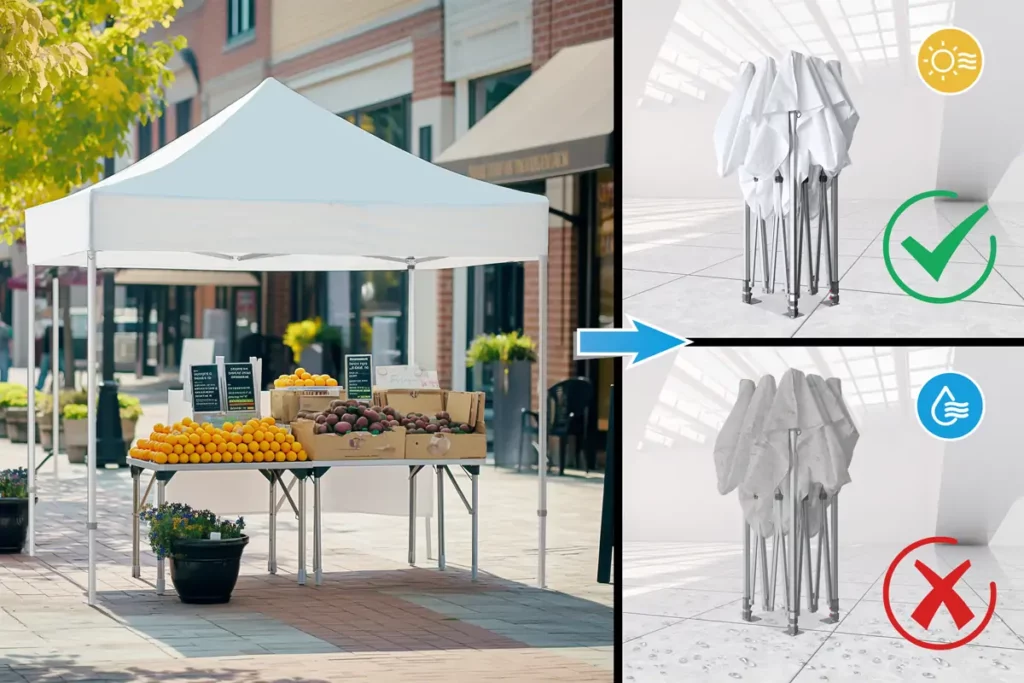
Canopy tents are useful for companies that attend outdoor events. From trade shows to local county fairs, these tents protect against the weather while also promoting your brand. However, once winter arrives, people won’t use them as much, since most events move indoors.
Some businesses still need to use their canopy tents throughout the winter, but most of them store them away for the season. While this might sound like an easy task, the reality is that a lot of preparation goes into it. That’s why we’re here to go over how to store a canopy tent for the winter. That way, you can rest easy knowing that it will be in the best condition possible come next spring.
Clean the Tent Off
Before you even think about packing up your tent for storage, you must start by thoroughly cleaning it. This equipment has seen its fair share of dirt throughout the year, not including other forms of debris like sticky tree sap or the always-unfortunate bird droppings. If stored dirty, these stains will only worsen and may cause long-term damage by the time you bring the tent back out in spring.
Fortunately, plenty of tent cleaning products exist for you to spray onto your canopy that will do a good job of cleaning off the dirt and debris. If you don’t have access to any of these specialty cleaners, water mixed with mild, non-detergent soap will also work well. However, tree sap will be a bit more troublesome. You’ll need to ensure it’s completely dry before using mineral oil or an alcohol-based product like wet wipes to get the sap off your canopy.
Regardless of your chosen cleaning method, you must ensure that the tent is completely dry afterward. Any leftover water residue could become the catalyst for mold or mildew while in storage, which will be much more difficult to clean off in the spring.
Don’t forget to clean the other parts of the tent as well, not just the canopy top. If you have any sidewalls, follow the same process as above. For the metal poles, though, you don’t have to do too much. Simply run some water over them to remove any stuck-on dirt and leave them out to air-dry for a bit.
Check for Any Damages
While cleaning or drying your canopy tent, take the time to inspect it closely for damage. Small rips and tears can be hard to spot from a distance, so run your hands over the canopy and sidewalls to catch weak spots. Even minor cuts can grow larger over time, so it’s best to patch or repair them right away. Putting the tent away and saying that you’ll fix them next year will almost certainly guarantee that you will forget until next winter.

Be sure to check the poles for damage, too. These will be much easier to spot. Tiny dings won’t be anything to worry about, but if any of them have a large dent or start, you’ll need to do something about it. Unfortunately, metal poles are difficult to bend back into place. Even if you do, it probably won’t be a permanent fix. The best thing you can do here is to replace your damaged poles.
If too many parts of your tent are past the point of repair, it might be better to buy a new one before next year. At Westshade, we offer a wide selection of durable pop-up canopies, whether you need a replacement canopy roof or a completely new tent. With multiple sizes and customization options available, you can easily find the perfect fit for your next event.
Pack and Protect Properly
Now that your tent is completely clean and you’ve repaired the damage, it’s time to get into the details of how you should store your canopy tent for the winter. The first step is to find a box or bag that will fit the tent.
Some canopies come with ones made specifically for them, so be sure to use that if you have it. These are useful, but avoid packing everything too tightly. Over-compression can stretch the fabric, strain the seams, and leave your canopy loose or more prone to tearing next season. Instead, you want a box or bag with enough room to fit the materials in more loosely.
Regardless of how you pack away the canopy and sidewalls, you should try to store the poles in a different container. Shoving these into a bag with your fabrics could lead to rips or tears that you could have easily avoided otherwise.
Choose a Good Storage Spot
The final step is choosing a safe place to store your canopy tent. Avoid damp areas like basements, which can introduce moisture, mold, and mildew. Unheated garages or sheds are also poor choices. Since exposure to freezing temperatures can make fabric brittle and cause cracks over time.
The best option is a cool, dry indoor space such as a closet or dedicated storage room. Store the tent in an accessible spot rather than burying it under other items. This way, you’ll avoid digging it out in spring or struggling to find it if you need it unexpectedly during the winter.
Conclusion
Proper winter storage keeps your canopy tent in top shape for next season. Clean, repair, pack, and store it in a dry, accessible spot.
If it’s time for an upgrade, Westshade offers a wide range of durable, high-quality pop-up canopies in various sizes, with customizable options to suit any business or event. Whether you need a standard custom tent 10×10 or a larger custom canopy 10×20, Westshade has the perfect solution to make your setup easy and reliable year after year. Check it out and get the perfect fit for your next event.







